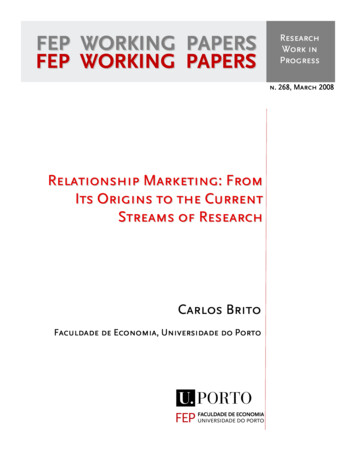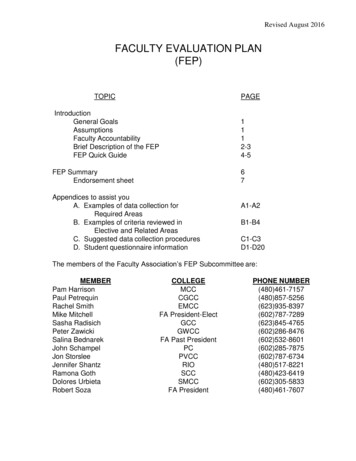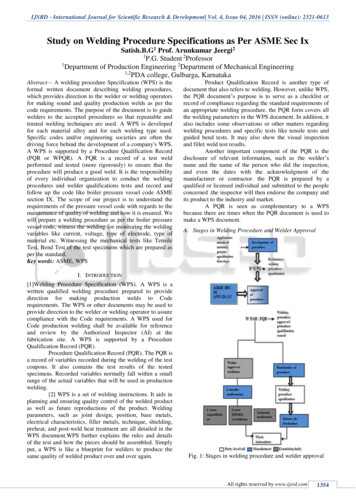
Transcription
"!# %&! ''&
RELATIONSHIP MARKETING:FROM ITS ORIGINS TO THE CURRENT STREAMS OF RESEARCHCarlos Britocbrito@fep.up.ptFaculty of de EconomicsUniversity of PortoABSTRACTAs companies increasingly recognize the importance of interaction with customers,relationship marketing is assuming a central place in both marketing theory and practice. Thepurpose of this working paper is to offer a general overview of the roots of relationshipmarketing as well as of its conceptual background. In this regard, two important streams ofresearch are examined and discussed – the Nordic School and the IMP Group. Thecontributions of the Anglo-Australian School and the relationship approach to branding arealso considered.Key words: relationship marketing, transaction marketing, services, business-to-businessmarketing, distribution channels, branding.JEL classification: M311
1. INTRODUCTIONAt a time of intense competition and increasingly demanding consumers, relationshipmarketing has attracted the attention of both researchers and managers. Academics havefocused their attention on its scope, and developed a conceptual framework aimed atunderstanding the nature and value of the relationships not only with customers but also witha number of other stakeholders. Many researchers with varied interests in the field ofmarketing – such as distribution channels, services marketing, business-to-business marketingand marketing communication – have studied and explored the conceptual fundamentals ofrelationship marketing and its application in the business world (Palmer, Lindgreen andVanhamme, 2005). It is in this context that in 1994 Grönroos stated that relationshipmarketing would probably turn into one of the dominant paradigms in marketing theory.What are the origins of this approach? It is generally accepted that the roots of the expression“relationship marketing” can be found in the early 1980s. It appears for the first time inacademic literature in 1983 when Leonard Berry, in a book on marketing to services, writes achapter entitled “Relationship Marketing.” Two years later, in the context of a project relatedto industrial marketing, Barbara Jackson uses the same expression of “relationship marketing”in her book Winning and Keeping Industrial Customers as well as in an article published inHarvard Business Review in 1985. This fact bears mentioning: the two researchers whointroduced the expression – one in the area of services and the other in the industrial field –indicate, to some extent, its conceptual pillars. Finally, we must also mention the greatTheodore Levitt, who in 1983, without using the term “relationship marketing” in those exactwords, states that the objective of a business should not be limited to sales in itself but shouldalso provide the greatest customer satisfaction, which depends on “how well the relationshipis managed by the seller” (Levitt, 1983, p. 111).In 25 years, relationship marketing has undergone a significant evolution, with its currentstatus undeniable. A recent Google search showed close to 8,000,000 hits for the search term“relationship marketing”. On the other hand, the American Marketing Association changedits definition of marketing in 2004, putting in evidence its relational nature: “marketing is anorganizational function and a set of processes for creating, communicating, and deliveringvalue to customers and for managing customer relationships in ways that benefit theorganization and its stakeholders.” It is interesting to compare this definition with the one2
adopted before: “marketing is the process of planning and executing the conception, pricing,promotion, and distribution of goods, ideas, and services to create exchanges that satisfyindividual and organizational goals.” It should be noted that the Journal of Public Policy &Marketing published a special issue at the end of 2007 dedicated to the theme of “TheAmerican Marketing Association’s New Definition of Marketing: Perspectives on ItsImplications for Scholarship and the Role and Responsibility of Marketing in Society”, whichreveals how the definition of marketing has changed its focus.Furthermore, in its report on research priorities for 2006-2008, the Marketing ScienceInstitute clearly stated that customer relationship management is one of the most relevantareas. They have stated that “realizing that their customers now have better opportunities forswitching suppliers or brands, our companies are looking for ways to engage their customersand thus strengthen customer loyalty. Loyalty programs have been in place for some time, butcan they be maintained without damaging long-turn profitability? Companies are interested indiscovering new ways to create and sustain emotional connections with the brand” (MarketingScience Institute, 2006, p. 4).The goal of this paper is twofold: to show how relationship marketing emerged, and toexamine its most relevant streams of research. Beyond this introductory section, the paperincludes three main sections. The first offers an overview of the origins of relationshipmarketing, focusing not only on scientific issues but also on those most associated with thebusiness world. The second section discusses the concept of relationship marketing and howits scope is addressed by the most important literature. The final section focuses on the mostsignificant schools of thought.2. THE ORIGINS OF RELATIONSHIP MARKETINGIn the academic field, a number of prestigious conferences as well as some special issues ofimportant journals have contributed to the current level of relevance of relationshipmarketing. Notable is a series of conferences promoted by the International Colloquium ofRelationship Marketing (the first of which was held at Monash University in Australia in1993), the conferences at Emory University which also began in the same year, the seminar3
organized by the American Marketing Association in Berlin (1996) and the Dublin conferencein 1997. As for publications, the most important are the special issues on the theme in theJournal of the Academy of Marketing Science (1995), the European Journal of Marketing(1996), the Asia-Australia Marketing Journal (1996) and the Journal of MarketingManagement (1997).In the business world, there are also various factors that have increased the importance ofrelationship marketing. Several authors (cf. Brito, 1998; Dibb, 2001; Grönroos, 2007; Laraand Casado, 2002; Little and Marandi, 2003; Sheth and Parvatiyar, 1995, 2000) have shownwhich changes, both on the supply and demand side, have increased the strategic importanceof more relationship-oriented approaches. Among the factors most generally mentioned are:(i) the tendency for lesser effectiveness of mass-market approaches, (ii) the advances in thefield of new technologies, not only in terms of communication and information but also inproduction and logistics, (iii) the high level of competition seen in the increasing number ofavailable brands, ones often viewed as having little that distinguishes one from another, (iv)the growing importance of services, (v) the emergence of new business models based onpartnerships and networks, fostered by the process of globalization.With this being the academic and business framework in which relationship marketing hasbeen developing and affirming itself, it becomes interesting to perceive in a more precise waywhat its theoretical foundations are. Based on Eiriz and Wilson (1999, 2006) and Möller andHalinen (2000), as well as on the contributions of other important researchers (Brodie et al.,1997; Coviello et al., 1997; Gummesson, 1996; Mattsson, 1997; Morgan and Hunt, 1994), theconceptual origins of relationship marketing can be found in essentially four areas: supplychain and marketing channels, organizational marketing, services marketing, and database anddirect marketing (Figure 1).4
Figure 1Conceptual Roots of Relationship etingSources: Eiriz and Wilson, 2006, p. 282; Möller and Halinen, 2000, p. 32 (adapted)Supply Chain and Marketing ChannelsSome of the most important issues on distribution channels – whose origins go back to the1970s (cf. El-Ansary and Stern, 1972; Rosenberg and Stern, 1971; Stern, 1969) – deal withthe conflict of power in the context of the buyer-seller interaction process. In general, theunderstanding and explanation of structures of governance and the nature of the two-waybehavior of the parties is sought. In this vein, most studies have focused on interorganizational relationships, namely within a perspective of efficiency of economictransactions (Heide and John, 1990), although there is also research centered on social aspectsand economic policy (Reve and Stern, 1985). Important references in the area, beyond theones mentioned above, are Anderson and Narus (1984, 1990), Geyskens et al. (1998),Grundlach et al. (1995) and Joshi (1995), among others.5
Organizational MarketingThe literature on distribution channels has contributed in part to the emergence of animportant stream of research on interaction and inter-organizational networks, the mostprominent research group of which is the IMP – Industrial Marketing and Purchasing.Primarily European, its main research centeres are in the Nordic Countries (such as theUppsala University and the Stockholm School of Economics), as well as in the UnitedKingdom, where the Universities of Lancaster, Manchester (at the time called UMIST –University of Manchester Institute of Science and Technology) and Bath deserve specialmention. With their initial studies centered on the understanding of two-way interaction at theorganizational level (cf. Ford, 1980; Håkansson, 1982; Turnbull and Valla, 1986), later workwas advanced toward a more integrated and wide-reaching network approach (cf. Axelssonand Easton, 1992; Ford et al., 1998; Gadde and Håkansson, 2001; Håkansson, Harrison andWaluszewski, 2004; Naudé and Turnbull, 1998).Services MarketingThe third theoretical area on which relationship marketing is founded is services marketing.Since the late 1970s, researchers in this area have shown that the development of a conceptualframework for services based exclusively on the traditional approach of product marketingmix was manifestly insufficient (Parasuraman, Zeithaml and Berry, 1985). Customerparticipation, not only in consumption but also in the production of the service, in conjunctionwith the simultaneity seen between both processes – something that came to be called‘servuction’ by Eiglier and Langeard (1987) – made clear the relational nature of services.Important contributions in this field deal with quality management and its association withcustomer satisfaction (an idea that became central to relationship marketing), as well as theimportance of people and processes in service quality. Important references in this field aretwo authors of the Nordic School (Grönroos, 1990, 1994, 2007; Gummesson, 1991, 1993,2002) as well as Crosby et al. (1990), Gwinner et al. (1998), Rust et al. (1996) and Zeithamlet al. (1990).Database Marketing and Direct MarketingFinally, the fast development of information and communication technologies over the pasttwo decades has acted as a catalyst for more interactive market approaches. The capacity for6
storing and extracting data offered by new technologies – allowing for what is commonlyknown as data warehouse and data mining – has increased the ability of organizations to dealwith a vast quantity of information from customers that it would otherwise be unthinkable.From the point of view that marketing is viewed as a support tool, the truth is that newinformation and communication technologies have greatly advanced the capacity forindividualized management of customer relationships. O’Connor and Galvin (1997), Rust andKannan (2003), Swift (2001) and Tapp (1998) are some of the most important researchers inthis field.3. THE SCOPE OF RELATIONSHIP MARKETINGWith these as the roots of relationship marketing, the truth is that we confront a relativelyrecent theoretical field where a wide consensus does not yet exist about what the conceptentails (Grönroos, 2006a). To illustrate this point, the following definitions from some of themost respected authors on the subject include:“Relationship marketing concerns attracting, developing, and retaining customerrelationships” (Berry and Parasuraman, 1991, apud Hunt et al., 2006, p. 73).“Relationship marketing is the understanding, explanation, and management of theongoing collaborative business relationships between suppliers and customers”(Sheth, 1994, apud Hunt et al., 2006, p. 73).“Relationship marketing is to identify and establish, maintain, and enhancerelationships with customers and other stakeholders, at a profit, so that theobjectives of all parties involved are met; and this is done by a mutual exchangeand fulfilment of promises” (Grönroos, 1996, p. 11).7
“Relationship marketing is marketing based on interaction within networks ofrelationship” (Gummesson, 2002, p. 3).Among these four definitions, the first has a more limited scope – since it deals with therelationships with customers – whereas the others are broader, given that they include otheractors besides the customers. Sheth (1994) refers explicitly to suppliers and customers,Grönroos (1996) goes further and includes other stakeholders, and Gummesson (2002) goeseven further and does not refer to any particular type of actor, speaking about networks. It isnot by chance that this happens. These quotations are cited in chronological order, whichleads us to state that the initial conceptions of relationship marketing were more focused onthe customers, whereas the more recent ones tend to be more encompassing.It is in this line that Parvatiyar and Sheth (2000) speak of the narrow versus broad views ofrelationship marketing. One of the more daring definitions – and also one of the least precise– is that of Morgan and Hunt (1994). On the basis of the work of Dwyer, Schurr and Oh(1987), the authors state that “relationship marketing refers to all marketing activities directedtowards establishing, developing, and maintaining successful relational exchanges” (op. cit.,p. 22). It should not be surprising that such a broad definition has been criticised by variousauthors. For example, Peterson (1995, p. 279) states that “if the definition [of Morgan andHunt] is true, then relationship marketing and marketing are redundant terms and one isunnecessary and should be stricken from the literature because having both only leads toconfusion.”In any event, Morgan and Hunt’s definition has merit insofar as it addresses the distinctionbetween transaction marketing and relationship marketing. Indeed, the process of creatingvalue is different in the two cases, as can be seen in Figure 2. While in transaction marketingthe aim is to deliver value to the customer (who will rate it with regard to the resultsobtained), in the relationship perspective the customer tends to be involved in the process ofvalue creation.Transaction marketing basically corresponds to the above-mentioned definition that theAmerican Marketing Association adopted up to 2004: “marketing is the process of planningand executing the conception, pricing, promotion, and distribution of goods, ideas, andservices to create exchanges that satisfy individual and organizational goals” In other words,transaction marketing – unduly referred to as ‘traditional marketing’ in certain types of8
literature – addresses the classical threesome of segmentation, targeting and positioning aswell as the management of the 4 P s, i.e. marketing mix variables.Figure 2Exchange versus Relational rce: Sheth and Parvatiyar, 1995, pp. 400 e 412 (adapted)Although the literature distinguishes transaction marketing from relationship marketing, thereis some consensus on the fact that the two approaches do not constitute extreme points oralternative opposites, and that they should be viewed as a continuum (Grönroos, 2007;Gummesson, 2002). This means that a company can adopt a more transaction-orientedmarketing or a more relationship-based approach (Figure 3). Gummesson (2002), quotingJackson (1985a), states that “relationship marketing can be extremely successful where it isappropriate – but it can also be costly and ineffective if it is not. Conversely, transactionmarketing can be profitable and successful where it is appropriate, but a serious mistakewhere it is not” (op. cit., 18).9
Figure 3The Continuum between Transaction Marketing and Relationship Average customerFocus on the marketing mixvariablesMarketing mix more standardizedMANAGINGRESOURCESActionEconomies of scale and synergiesMarket shareSales à Single purchaseIndividual customerFocus on interaction andrelationshipsMarketing mix more nt in relationshipsPortfolio of customersLoyalty à repeated purchaseA slightly different perspective from that of Grönroos and Gummesson – for whomtransaction marketing and relationship marketing are the poles of a continuum – is that of Pelset al. (2000). These authors suggest that it is not a question of a company assuming a posturethat is more transactional or more relationship-oriented. To the contrary, “the transactionalparadigm and the relationship-oriented (as well as the relevant approaches to the practice ofmarketing that they imply) are both appropriate,” (op. cit., p. 16). In other words, transactionmarketing can be regarded as the base, i.e. the ‘foundations of the house.’ Without a correctsegmentation of the market, without a choice of the targets, without an adequate positioning,without an effective management of the marketing mix variables, a company will be hardpressed to succeed. The question is not to be less transactional in order to become morerelationship-oriented, or vice-versa. The question is in having to become transactional(because this is probably the basis of the approach) then being able to more or less pursue arelationship management. As these authors asserted (p. 16), everything depends on “thecontext of the market, the perception or interpretation that the buyer and seller have of this10
same context, as well as their perceptions on the way that the interaction can influence theirsituation in the market.”A similar position was recently contended by Kristian Möller at the 36th EMAC Conferenceheld in May of 2007. In the presentation he made there, the author began by affirming that “animportant theme in the theory discourse is the strong criticism directed towards theManagerial School of Marketing (Sheth et al., 1988), and especially to the Marketing Mixframework. This criticism is quite diverse. Grönroos (1994), for example, suggested that the[marketing] mix is void of theoretical foundation, forming primarily a mnemonic device forstudents and managers (Dixon and Blois, 1983)” (Möller, 2007, p. 1). The Managerial Schoolof Marketing is that which – set upon the triad of segmentation, targeting and positioning –asserts that marketing management is done essentially on the basis of a series of variablesthat, taken together as a whole, constitute the marketing mix. Philip Kotler is generallyconsidered the most representative author of this school (cf. Kotler, 2002). This paper doesnot aim to discuss the criticism of that school of thought – for those so interested, acomprehensive view can be found in Constantinides (2006) and Vargo and Lusch (2004).However, Möller (2007, p. 5) concludes that “the Managerial School of Marketing providesstill the best approach for those marketing management decision contexts where there exist amarket of customers or a set of customer relationships, which are characterized by market likeexchange conditions”.To sum up, there are two broad aspects to be kept in mind. First, it is not a question of optingfor relationship marketing or transaction marketing. The marketing approach of anorganization is simply one of a relationship-oriented nature, be it to a greater or lesser degree.Second, relationship marketing, far from being a panacea that is in fashion, should only beused in proper measure, with regard to the dictates of market conditions and the needs of thecompany.11
4. CURRENT STREAMS OF RESEARCHFinally, let us consider the current schools of thought with respect to those aspects ofrelationship marketing that have already been touched upon. There are two fields of researchthat must be mentioned: the Nordic School and the IMP Group.The Nordic SchoolEmerging from research undertaken primarily in the services field, important contributions inthe area of customer loyalty and satisfaction are owed to this school. In general, it is assumedthat the latter depends on the perceived quality, and for its part, is determined by two types offactors: the expectations of each customer in relation to the service to be offered and theperception of that service after it has been rendered.It is fitting here to recall two important things. First, from the marketing point of view, qualityis something that is the result of one’s perceptions. This means that the quality of any servicecan be seen in a distinctively unique way depending on the customer, since these perfectlyindividual perceptions correspond to what each person understands by the service. On theother hand is the issue of expectations. Indeed, quality that is perceived does not dependsolely on the perception of what is being offered, but also takes into account the comparisonthat the customer will make of that perception and the way it meets the expectations thathe/she had. Prominent names in this school of thought are the ones previously mentioned,Christian Grönroos and Evert Gummesson (Grönroos, 1990, 1994, 1996, 2000, 2006a, 2006band 2007; Gummesson, 1991, 1993, 1996, 1998 and 2002).IMP GroupThe IMP Group – Industrial Marketing and Purchasing has some of its roots in Scandinaviaalthough it has important research centers in the United Kingdom (namely the Universities ofLancaster, Manchester and Bath) and in France, with a special mention to Lyon. Portugalshould also not be left out, with a group of recent researchers spread out among theUniversities of Porto, Minho and Técnica in Lisbon (Brito, 1999; Brito and Roseira, 2007;Eiriz and Wilson, 2006; Mota and de Castro, 2004; Proença and de Castro, 2007).12
Quite centered in relationship studies, some of the most important theoretical developmentscoming out of the IMP Group are the interaction and network models, with a particularemphasis on an integrated and dynamic vision of the relationships established among actors,activities and resources. Prominent authors are Håkan Håkansson, Lars-Gunnar Mattsson, JanJohanson, Geoff Easton, David Ford, Peter Turnbull and Luís Araújo (cf. Araújo, Dubois andGadde, 2003; Axelsson and Easton, 1992; Ford et al. 1998, 2006; Håkansson, 1982, 1987,1989; Johanson and Mattsson, 1985; Turnbull and Valla, 1986).The Anglo-Australian SchoolIn addition to the research undertaken by the Nordic School and the IMP Group, worthy ofnote are the works of by the Anglo-Australian School. We refer specifically to the studies ofFrancis Buttle (Buttle, 1996 and 2004), and Martin Christopher, Adrian Payne and DavidBallantyne (Christopher, Payne and Ballantyne, 1991, 2002; Payne, Ballantyne andChristopher, 2005). Although today this group of authors is dispersed throughout the UnitedKingdom and Australia, their common denominator and origin is the Cranfield School ofManagement, where all four studied.To Buttle, credit is due for developments in the area of CRM (customer relationshipmanagement) and quality management, while for the other three authors, among othercontributions, special mention goes to the Six Markets Model. Essentially, this is a tool thatdeals with relationship management with the main stakeholders of a company: customermarkets, supplier and alliance markets, internal markets, recruitment markets, influencemarkets and referral markets.Relationship Approach to BrandingA final mention goes to the research done in the field of relationship branding. Although itdoes not appear as a ‘school’ of relationship marketing in the literature, the pioneering workof Susan Fournier in the field of the relationship between consumers and brands cannot be leftout. With a doctoral thesis entitled, “A Person-Brand Relationship Framework for StrategicBrand Management” (1994), Fournier initiated a stream of research that brings together twoareas of knowledge: brand management and consumer psychology.13
Fournier’s central idea is that customers establish relationships with brands not only becausethey offer functional benefits or because they simply like them. Customers tend to establishrelationships with brands in such a way that, during their life, they increase in value andsignificance over time. Some of these aspects can, in fact, be of a functional nature if theyresult from a utilitarian component of the brand. But others can be emotional with regard tothe feelings they display. Beyond Fournier, (1995, 1998), there is an important set ofresearchers who have approached brands from an eminently relationship-oriented point ofview, such as Aaker (1997), Aggarwal (2004), Fletcher and Simpson (2000) and LindbergRepo and Brookes (2004).5. CONCLUSIONRelationship marketing is today one of the areas with the most expression in the field ofmarketing, recognized not only by academics but also by practitioners. Its application in thebusiness world is ever more visible. It is not only the multiple direct marketing configurationsthat are being increasingly utilized and which enter the field (not being restricted to physicalmail) as mobile marketing. It is the individualization of products, it is the increasing use ofservices, it is loyalty programs – in fact, it is the multiple channels of interaction with thecustomer.However, beyond the practical side, relationship marketing is a field with a high potential forscholarship, given the multi-disciplinary nature of the issues that it encompasses, groupingtogether studies that span areas such as services and distribution channels and extend to brandmanagement, quality and customer loyalty. It spills over from the specific field of marketingand involves others, such as information systems (given the growing importance ofinformation and communication technology) and strategic organization, with the question ofnew business models.One thing is true: this is a field of research that, dealing with the developments that have beentaking place, cannot be discounted by those who, either from a theoretical or practical point ofview, wish to keep themselves up-to-date in the context of marketing.14
REFERENCESAaker, J. (1997), “Dimensions of Brand Personality”, Journal of Marketing Research, Vol.34, No 3, pp. 347-356.Aggarwal, P. (2004), “The Effects of Brand Relationship Norms on Consumer Attitudes andBehavior”, Journal of Consumer Research, Vol. 31, June, pp. 87-101.Anderson, J. and Narus, J. (1984), “A Model of the Distributor’s Perspective of DistributorManufacturer Working Relationships”, Journal of Marketing, Vol. 48, No 4, pp.62-74.Anderson, J. and Narus, J. (1990), “A Model of Distributor Firm and Manufacturer FirmWorking Partnerships”, Journal of Marketing, Vol. 54, No 1, pp. 42-58.Araújo, L, Dubois, A. and Gadde, L.-E. (2003), “The Multiple Boundaries of the Firm”,Journal of Management Studies, Vol. 40, No 5, pp. 1255-1277.Axelsson, B and Easton, G. (editors) (1992), Industrial Networks: A New View of Reality,Routledge, London.Berry, L. (1983), “Relationship Marketing”, in Berry, L. Shostack, G. and Upah, G. (editors),Emerging Perspectives in Services Marketing, American Marketing Association,Chicago, IL.Berry, L. and Parasuraman, A. (1991), Marketing Services, The Free Press, NY.Brito, C. (1998), A Insustentável Leveza do Marketing, working paper nº 81, Faculdade deEconomia do Porto.Brito, C. (1999), “Issue-Based Nets: A Methodological Approach to the Sampling Issue inIndustrial Networks Research”, Qualitative Market Research: An InternationalJournal, Vol. 2, No 2, pp. 92-102.Brito, C. and Roseira, C. (2007), “Towards a Multi-Dimensional Approach to SupplyManagement: A Comparative Case Study”, Journal of Business & IndustrialMarketing, Vol. 22, No 1, pp. 72-79.Brodie, R., Coviello, N. Brookes, R. and Little, V. (1997), “Towards a Paradigm Shift inMarketing? An Examination of Current Marketing Practices”, Journal ofMarketing Management, Vol. 13, No 5, pp. 383-406.Buttle, F. (editor) (1996), Relationship Marketing: Theory and Practice, Paul ChapmanPublishing, London.Buttle, F. (2004), Customer Relationship Management: Concepts and Tools, ButterworthHeinemann, Oxford.15
Christopher, M., Payne, A. and Ballantyne, D. (1991), Relationship Marketing: BringingQuality, Customer Service and Marketing Together, Butterwort-Heinemann,Oxford.Christopher, M., Payne, A. and Ballantyne, D. (2002), Relationship Marketing: CreatingStakeholder Value, Butterwort-Heinemann, Oxford.Constantinides, E. (2006), “The Marketing Mix Revisited: Towards the 21st CenturyMarketing”, Journal of Marketing Management, Vol. 22, No 3, pp. 407-438.Coviello, N., Brodie, R. and Munro, H. (1997), “Understanding Contemporary Marketing:Development of a Classification Scheme”, Journal of Marketing Management,Vol. 13, No 6, pp. 501-522.Crosby, L., Evans, K. and Cowles, D. (1990), “Relationship Quality in Services Selling: AnInterpersonal Influence Perspective”, Journal of Marketing, Vol. 54, No 3, pp. 6881.Dibb, S. (2001), “New Millennium, New Segment
conceptual origins of relationship marketing can be found in essentially four areas: supply chain and marketing channels, organizational marketing, services marketing, and database and direct marketing (Figure 1). 5 . Journal of Marketing Management, Vol. 10, No 5, pp. 347-360. Grönroos, C. (1996), "Relationship Marketing: Strategic and .











